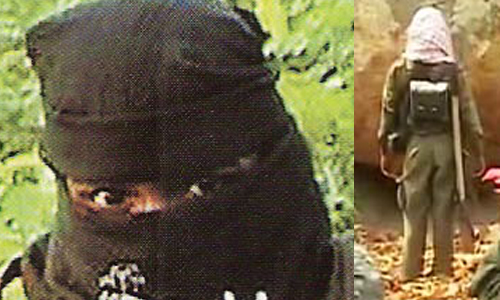
Odisha: Maoist Spike
On October 2, 2016, the dead body, with its throat slit, of a villager, identified as Budara Khilamali, was found at Katapali village under Maithili Police Station in Malkangiri District. Handwritten Maoist posters were recovered from the spot. According to reports, Maoists had taken Budara away in the night of October 1 to attend a Sabha (meeting).
On September 15, 2016, a woman cadre of the CPI-Maoist was reportedly killed in an encounter with the Police in the Niyamgiri Forest under the Lanjigarh Police Station in Kalahandi District. Police recovered one INSAS (Indian Small Arms System) rifle, one SLR (Self-Loading Rifle) and two other rifles from the encounter site.
According to partial data collated by the South Asia Terrorism Portal (SATP), at least 33 persons, including 19 civilians, two Security Force (SF) personnel, and 12 Maoists have already been killed in Odisha in Maoist-linked violence in the current year, till October 16, 2016; by comparison, 26 persons, including 13 civilians, four SF personnel and nine Maoists, were killed over the same period in 2015. The number of fatalities through 2015 totalled 33 (18civilians, four SF personnel and 11 Maoists).
The spike in Maoist related fatalities in 2016 reverses the declining trend that had been established since 2010.Maoist-related fatalities in Odisha had risen continuously between 2005 and 2010, with an aberration in 2009, but had started falling since, due to several factors. In October 2015, the Maoists had acknowledged that their Odisha unit had suffered huge losses following Sabyasachi Panda's parting of ways. The Maoists also had admitted that the surrender on October 28, 2014, of Nachika Linga, the head of the Chasi Mulia Adivasi Sangha (CMAS), a Maoist front organization that had spearheaded themass movement of 2006-09, impacted particularly adversely on the prospects of the organisation in the State.
Apart from the fatalities registered, the Maoists have also been involved in 20 exchange of fire incidents in the State in the current year (data till October 16), in comparison to 10 exchanges of fire in the corresponding period of 2015. The Maoists also engineered four explosions in 2016, in comparison to five explosions for the same period in 2015; and eight incidents of arson in 2016, as against four in 2015.The Maoists have also given bandh (general shutdown) call on four occasions, as against two in 2015.
Meanwhile, in an effort to increase their cadre strength, the Maoists have sought to force villagers to come to their meetings. In one such incident on October 7, 2016, about 25 armed Maoists organised a 20-minute-long meeting of youth on the village road at Bhurukundi village under the Purunakot Police limits in the Satkosia wildlife sanctuary of Angul District, exhorting them to join their cadre. They offered to pay them a 'monthly salary' of INR 10,000 each. It was reported that about 40 young men and women participated in the meeting out of fear, as the Maoists had threatened to blow up the village if the youth did not join their organisation. The Maoists retreated into the dense forests after the meeting. Sources revealed that the Maoists had held a similar meeting in the same village on October 4, 2016. No further detail is available about both these incidents.
It is evident from the recent spurt in the incidents of killing and other Maoist-activities in the State that an attempt is being to reclaim lost ground in the State. Between 2010 and 2012, fatalities were reported from at least 11 Districts, out of Odisha's 30 Districts. In 2014, such reports were received from just five Districts. This went up to seven in 2015. So far, in 2016, fatalities have already been reported from eight Districts.
Significantly, Director General of Police (DGP) Kanwar Brajesh Singh disclosed on September 18, 2016, that the State Police was formulating strategies to counter the Maoists' efforts to revive their bases in Odisha:"With the recent seizure of huge cache of arms and ammunitions and studying their movement and modus operandi, it is now apparent that the Red Rebels are trying their best to strengthen their base in the state.especially trying to regain their foothold in remote areas from Pottangi in Koraput District to Sundargarh District."
Further, on September 26, 2016, Rahul Dev Sharma, Superintendent of Police (SP), Visakha Rural, in the adjacent Visakhapatnam District of Andhra Pradesh, reiterated that the Maoists were active in the Galikonda area of Visakhapatnam District as well as in the cut-off areas in Visakhapatnam region, and were trying to regroup in the Andhra Odisha Border (AOB) region, including parts of Odisha.
The current surge of LWE-activities in Odisha can be attributed to theestablishment of new 'division'-the Odisha-Srikakulam Division -by the CPI-Maoists in the AOB region, to regain their hold in the Gunupur and Gudari Forest areas of Rayagada District, as well as the Srikakulam region in Andhra Pradesh.
A white paper published by the State Home Department on May 10, 2016, revealed that, while significant improvement was seen in Maoist situation in Jajpur, Dhenkanal, Gajapati, Ganjam, Nabarangpur, Keonjhar, Mayurbhanj, Sambalpur, Deogarh, Sundargarh and Nayagarh Districts during 2015, the situation in certain parts of Malkangiri, Koraput, Nuapada, Bolangir, Rayagada, Kandhamal, Baragarh and Kalahandi Districts remained challenging.
17 battalions of Central Armed Police Forces - eight battalions each of the Central Reserve Police Force (CRPF) and Border Security Force (BSF) and one battalion of the Commando Battalion for Resolute Action (CoBRA), a specialized unit of the CRPF, are presently deployed in Odisha. The Central Forces are largely located in Koraput, Rayagada, Malkangiri, Kalahandi, Keonjhar, Mayurbhanj, Nuapada and Kandhamal Districts. In an attempt to strengthen the security grid further Odisha Chief Secretary Aditya Prasad Padhi stated on June 21, 2016, that the Government would ask for two more battalions of Central Forces to tackle the LWEs in the State. No further information is available in this regard.
The CAPFs add to the State Police. However, the strength of the State Forces is quite abysmal. According to the Bureau of Police Research and Development (BPR&D) 2015 data, police-population ration in the State stood at 119.61 in 2015 (as on January 1, 2015) as compared to the national average of 138.92. Vacancies at the leadership level in the Police, i.e. at the Indian Police Service (IPS) level, stand at 79, against 188 sanctioned IPS posts. Past experience has shown that, while normalcy can be attained in any insurgency affected area with the help of Central Forces, it can only be sustained by improving the strength and quality of the State Police. In 2004, the Odisha Government formed Special Operation Group (SOG), a specialised anti-Maoist force trained in anti-insurgency operations. According to media reports, SOG has scored major successes against Maoists in the southern Odisha Districts. The Force, which had a reported strength of 563 personnel in the beginning, now has over 2,200 personnel.
Despite loses, the Maoists have demonstrated enormous resilience and capacities for recovery in the past. Unless the Police and administrative machinery of the State is enormously improved, a consolidation of the present gains against the Maoists are likely to prove ephemeral.
Support Our Journalism
We cannot do without you.. your contribution supports unbiased journalism
IBNS is not driven by any ism- not wokeism, not racism, not skewed secularism, not hyper right-wing or left liberal ideals, nor by any hardline religious beliefs or hyper nationalism. We want to serve you good old objective news, as they are. We do not judge or preach. We let people decide for themselves. We only try to present factual and well-sourced news.







